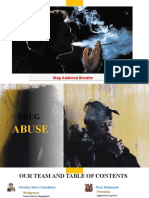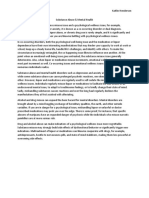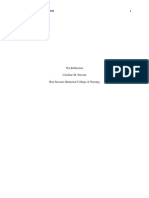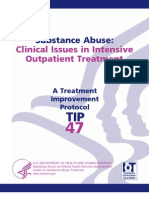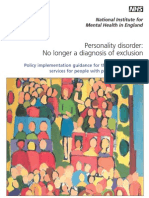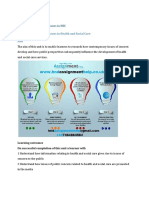Substance Abuse
Substance Abuse
Uploaded by
Intoaction TreatmentCopyright:
Available Formats
Substance Abuse
Substance Abuse
Uploaded by
Intoaction TreatmentCopyright
Available Formats
Share this document
Did you find this document useful?
Is this content inappropriate?
Copyright:
Available Formats
Substance Abuse
Substance Abuse
Uploaded by
Intoaction TreatmentCopyright:
Available Formats
Lissi Seneway, M.S.
Michael MelicharMS, CAP Into Action Clinical Director Treatment 855-933-6732
A disease is an illness, a sickness that causes an interruption, cessation, or disorder of bodily functions, systems, or organs A disease is an entity characterized by at least 2 of these criteria: 1) A recognized etiological agents or agents; 2) An identifiable group of signs and symptoms; or 3) Consistent anatomical alterations of known body systems
WHO (World Health Organization) AMA (American Medical Association) APA (American Psychiatric Association) Hughes Act of 1970; NIAAA established
Magnus Huss: Swedish Physician (18071890) was the first to systematically classify the damage that was attributable to alcohol ingestion. Huss coined the term alcoholism and used it to label what he considered to be a chronic, relapsing disease E. Morton Jellinek: A biostatistician and physiologist whose work on alcoholism was pivotal in the AMA recognizing alcoholism as a disease in 1956
Describes an addiction as a life-long disease involving biological and environmental sources of origin Addiction is a disease in the same sense as diabetes is a disease Chronic, incurable, potentially fatal Genetic predisposition: Twin Studies RFI believes in the Disease Model of Addiction, and treats it as such
Depressants Opioids Stimulants Psychogenics Designer Drugs Inhalants OTC (Over the Counter)
Alcohol Benzodiazepines (Xanax, Klonopin, Ativan, Librium) Barbiturates (Seconol, Tuenal, Phenobarbital)
Opiates, pain killers; obtained legally by a prescribing physician Codeine OxyContin Morphine Percocet Roxycodone (Blues) Heroin an illegal opioid drug synthesized from morphine, which is a derivative of the opium poppy
Cocaine Crack-Cocaine Amphetamine (Prescription Adderrol, Ritalin, Vyvance) Methamphetamine Caffeine Nicotine BOUNS QUESTION: What is the most common stimulant abused in America?
Lysergic acid diethylamide (LSD,Acid) Marijuana Psilocybin mushrooms Mescaline
MDMA (Ecstasy) GHB Ketamine Rohypnol (Roofies)
Diagnostic and Statistical Manual of th Mental Disorders, 5 Edition Provides criteria for the medical filed and mental health professionals to diagnosis addictive disorders, such as alcohol dependence, cocaine dependence, opioid dependence, etc.
3 or more in a 12 month period:
Tolerance Withdrawal symptoms Substances taken in larger amounts and for longer period than intended Persistent desire or repeated unsuccessful attempts to quit Much time/activity to obtain, use, recover Important social, occupational, or recreational activities given up or reduced Continued use despite knowledge of adverse consequences
Withdrawal symptoms are medically treated and minimized by a medical protocol Initial 3-10 days the body is in acute withdrawal and adjusting to not having its substances The initial detox process does not fully eliminate the body from the substances Dangers alcohol and benzodiazepine withdrawal
Post: After Acute: Brief and Severe Withdrawal: The body and brains continued path towards detoxification after the initial detox protocol Symptoms: Set of impairments
Sensitivity to stress Anxiety Agitation Mood swings Poor motor coordination Memory impairment Sleep and appetite disturbance Cravings
Frequently utilized model today Includes detoxification, psychoeducation, skills-building, group therapy, family involvement, relapse prevention, referral to 12 step Addresses genetic/biological, sociocultural roles in etiology, treatment course, and outcome
http://en.wikipedia.org/wiki/Disease_theory_of_alcoholism http://drugabuse. gov/ResearchReports/Prescription/prescription2.html#Opioids
You might also like
- Clozapine Initiation and MaintenanceDocument15 pagesClozapine Initiation and MaintenanceDiana LasluizaNo ratings yet
- The Spectrum of Addiction: Evidence-Based Assessment, Prevention, and Treatment Across The LifespanDocument20 pagesThe Spectrum of Addiction: Evidence-Based Assessment, Prevention, and Treatment Across The Lifespanalexandra marulandaNo ratings yet
- Dast 10 PDFDocument1 pageDast 10 PDFNik DNo ratings yet
- Drug Abuse and AddictionDocument17 pagesDrug Abuse and AddictionSyafiqah ZainordinNo ratings yet
- The Prevalence of Substance Use and Other Mental Health Concerns Among American AttorneysDocument7 pagesThe Prevalence of Substance Use and Other Mental Health Concerns Among American AttorneysDavid AndreattaNo ratings yet
- GL2006 019Document195 pagesGL2006 019GNo ratings yet
- V SpeedsDocument7 pagesV SpeedsRick du PreezNo ratings yet
- CMT BookDocument45 pagesCMT Bookprem sagar50% (2)
- Characteristics of A Healthy FamilyDocument6 pagesCharacteristics of A Healthy FamilyJoebet Caspillo PalmairaNo ratings yet
- Psychiatric Diagnosis: Challenges and ProspectsFrom EverandPsychiatric Diagnosis: Challenges and ProspectsIhsan M. SalloumRating: 5 out of 5 stars5/5 (1)
- Inaba Current TrendsUppers, Downers, All Arounders Naadac AtlantaDocument236 pagesInaba Current TrendsUppers, Downers, All Arounders Naadac Atlantaalimusa1100% (3)
- Use Drugs - Pay To Die Drugs AddictionDocument11 pagesUse Drugs - Pay To Die Drugs AddictionelvineNo ratings yet
- Substance Abuse Power PointDocument65 pagesSubstance Abuse Power PointFletcher1980No ratings yet
- DSM 5. Historical Perspectives. Jordan, Rolin & Grund (2013)Document9 pagesDSM 5. Historical Perspectives. Jordan, Rolin & Grund (2013)Diego Martinez SantanaNo ratings yet
- Midyear Training CADCA MYTI14 - Program - FinalDocument48 pagesMidyear Training CADCA MYTI14 - Program - FinalRuss BelvilleNo ratings yet
- PDF Drugs, Society, and Human Behavior 18th Edition Carl L. Hart. downloadDocument49 pagesPDF Drugs, Society, and Human Behavior 18th Edition Carl L. Hart. downloadsaoryarhp100% (2)
- A Reading On Substance Abuse and Nursing - Patient InteractionDocument10 pagesA Reading On Substance Abuse and Nursing - Patient InteractionyuviebNo ratings yet
- Drug Addiction by .Final - EPI.V5Document52 pagesDrug Addiction by .Final - EPI.V5Mohaiminur RahmanNo ratings yet
- Co-Occurring Addiction and Mental DisordersDocument98 pagesCo-Occurring Addiction and Mental DisordersAnonymous nz9rhHNo ratings yet
- Ethical Issues in Clinical Forensic PsychiatryFrom EverandEthical Issues in Clinical Forensic PsychiatryArtemis IgoumenouNo ratings yet
- ClassificationDocument83 pagesClassificationDisha SharmaNo ratings yet
- Drugs & Substance AbuseDocument22 pagesDrugs & Substance AbuseRajaraamanSrinivasNo ratings yet
- Research PaperDocument16 pagesResearch Paperapi-559296640No ratings yet
- Psychiatric Services in Jails and PrisonsDocument99 pagesPsychiatric Services in Jails and PrisonssiralkNo ratings yet
- Consultation-Liaison Psychiatry (Psychosomatic Medicine) : M.Zainie Hassan A.RDocument25 pagesConsultation-Liaison Psychiatry (Psychosomatic Medicine) : M.Zainie Hassan A.RDavi DzikirianNo ratings yet
- Reading On Substance Abuse-MataDocument13 pagesReading On Substance Abuse-MataNicole Keesha MataNo ratings yet
- Alcoholism and Psychiatric - Diagnostic Challenges PDFDocument9 pagesAlcoholism and Psychiatric - Diagnostic Challenges PDFmirtaNo ratings yet
- Midterm Exam Study GuideDocument6 pagesMidterm Exam Study GuideDel KenzieNo ratings yet
- PPDGJ 3 PDFDocument279 pagesPPDGJ 3 PDFtri ummiNo ratings yet
- Substance Abuse & Mental HealthDocument1 pageSubstance Abuse & Mental Healthkaitlin100% (1)
- CV Vivek Benegal 0610Document16 pagesCV Vivek Benegal 0610bhaskarsg0% (1)
- 7teste Gramatica RomanaDocument37 pages7teste Gramatica RomanaStacia CunninghamNo ratings yet
- AIMS. Scales-Abnormal-Involuntary-Movement-Scale PDFDocument2 pagesAIMS. Scales-Abnormal-Involuntary-Movement-Scale PDFVictoria RomeroNo ratings yet
- DSM 5 Clinical Cases - Schizophrenia and Other Psychotic DisordersDocument20 pagesDSM 5 Clinical Cases - Schizophrenia and Other Psychotic DisordersAlexandra MurdyNo ratings yet
- Update On The Efficacy of Pharmacotherapy For Social Anxiety Disorder: A Meta-AnalysisDocument12 pagesUpdate On The Efficacy of Pharmacotherapy For Social Anxiety Disorder: A Meta-AnalysisAnaaaerobios100% (1)
- Initial Hospital Visit Inpatient Consult NoteDocument6 pagesInitial Hospital Visit Inpatient Consult NoteJanu easwarNo ratings yet
- TADCP 9th Annual Drug Court Conference AgendaDocument15 pagesTADCP 9th Annual Drug Court Conference AgendatadcpNo ratings yet
- Introduction in Clinical Psychology: PsychopharmacologyDocument67 pagesIntroduction in Clinical Psychology: PsychopharmacologyŞterbeţ RuxandraNo ratings yet
- Mental Health & Substance Abuse Drug Abuse Monitoring SystemDocument29 pagesMental Health & Substance Abuse Drug Abuse Monitoring SystemRavi Gaura Das100% (1)
- Effects of MisalignmentsDocument185 pagesEffects of MisalignmentslukaNo ratings yet
- Linda Carter Sobell - Mark B. Sobell - Group Therapy For Substance Use Disorders - A Motivational Cognitive-Behavioral Approach-Guilford Publications (2011)Document258 pagesLinda Carter Sobell - Mark B. Sobell - Group Therapy For Substance Use Disorders - A Motivational Cognitive-Behavioral Approach-Guilford Publications (2011)Sena UysakNo ratings yet
- Milestone StudiesDocument75 pagesMilestone StudiesPriyash JainNo ratings yet
- Case ReportDocument58 pagesCase ReportMahnoor MalikNo ratings yet
- Na ReflectionDocument6 pagesNa Reflectionapi-433710976No ratings yet
- Suicide Prevention Strategies Revisited 10-Year SystematicDocument14 pagesSuicide Prevention Strategies Revisited 10-Year Systematicmary morelliNo ratings yet
- Psychiatry Online - American Journal of Psychiatry - Psychiatric Disorders inDocument13 pagesPsychiatry Online - American Journal of Psychiatry - Psychiatric Disorders inAnnemarie AppletonNo ratings yet
- CEP BPSD Discussion Guide ENG RFCG Updated2019 PDFDocument8 pagesCEP BPSD Discussion Guide ENG RFCG Updated2019 PDFM.DalaniNo ratings yet
- 00072-Tip 47Document294 pages00072-Tip 47losangeles100% (3)
- Personality Disorder - No Loger A Diagnosis of ExclusionDocument54 pagesPersonality Disorder - No Loger A Diagnosis of ExclusionsanhourieNo ratings yet
- Suffolk County Substance Abuse ProgramsDocument44 pagesSuffolk County Substance Abuse ProgramsGrant ParpanNo ratings yet
- 12 Core FunctionsDocument14 pages12 Core Functionszaelany jrNo ratings yet
- The Unique Role of Attachment Dimensions and Peer Drinking in AdolescentDocument5 pagesThe Unique Role of Attachment Dimensions and Peer Drinking in AdolescentFrancisCevallosNo ratings yet
- The Drug Abuse Screening Test (DAST)Document1 pageThe Drug Abuse Screening Test (DAST)Cesar OstolazaNo ratings yet
- Week 2 (OSCE CASC Book II 2018-19) 03.09.2018Document48 pagesWeek 2 (OSCE CASC Book II 2018-19) 03.09.2018Andrew WdsmithNo ratings yet
- Nutrition BehaviourDocument95 pagesNutrition BehaviourMopawa Software LimitedNo ratings yet
- Adolescent Depression Literature ReviewDocument8 pagesAdolescent Depression Literature ReviewShowbiz ExposeNo ratings yet
- UNODC Assessment of Drug Abuse Treatment Services in AlbaniaDocument16 pagesUNODC Assessment of Drug Abuse Treatment Services in AlbaniaErlind Plaku100% (1)
- Calgary Depression Scale For Schizophrenia (CDSS)Document1 pageCalgary Depression Scale For Schizophrenia (CDSS)Edward Arthur IskandarNo ratings yet
- AsfdafsdDocument125 pagesAsfdafsdfrankmalcovNo ratings yet
- On Co-Occurring Addictive & Mental Disorders A Brief History. Kathleen SciaccaDocument5 pagesOn Co-Occurring Addictive & Mental Disorders A Brief History. Kathleen SciaccaKathleen Sciacca, MA - Sciacca Comprehensive Service Dev. Dual Diagnosis; Motivational Interviewing100% (1)
- 07 English Ocd BookletDocument27 pages07 English Ocd BookletJona JoyNo ratings yet
- SIKA - Sikagard-62Document3 pagesSIKA - Sikagard-62Adhigana QSNo ratings yet
- Ujian Satuan Pendidikan (Usp) TAHUN PELAJARAN 2021/2022: Pemerintah Provinsi Jawa TimurDocument11 pagesUjian Satuan Pendidikan (Usp) TAHUN PELAJARAN 2021/2022: Pemerintah Provinsi Jawa TimurFia DhalemNo ratings yet
- Giz Grey Water Recycling and Reuse 2011Document94 pagesGiz Grey Water Recycling and Reuse 2011v adamNo ratings yet
- NexusDocument17 pagesNexusVignesh ReddyNo ratings yet
- G11 Ex Fix PrinciplesDocument66 pagesG11 Ex Fix PrinciplesDeep Katyan DeepNo ratings yet
- Pps Fold (1) - 1Document23 pagesPps Fold (1) - 1srilikki16No ratings yet
- PD 705Document22 pagesPD 705Lester BalagotNo ratings yet
- Wiley - Momentum, Direction, and Divergence - 978-0-471-02729-4Document3 pagesWiley - Momentum, Direction, and Divergence - 978-0-471-02729-4Alex BrightNo ratings yet
- Malaysia Final Examination: UniversitiDocument8 pagesMalaysia Final Examination: UniversitiIzzat Khair Bin MahmudNo ratings yet
- Worksheet VLANDocument28 pagesWorksheet VLANRimpesh KatiyarNo ratings yet
- HCIA-Intelligent Computing V1.0 Lab GuideDocument213 pagesHCIA-Intelligent Computing V1.0 Lab GuidearsiemarNo ratings yet
- K R Balaramdas GoodcvDocument2 pagesK R Balaramdas Goodcvapi-745127466No ratings yet
- ©ian Sommerville 2000 Software Engineering, 6th Edition. Chapter 1 Slide 1Document30 pages©ian Sommerville 2000 Software Engineering, 6th Edition. Chapter 1 Slide 1Muhammad TalhaNo ratings yet
- Mayer Expansions Hamilton Jacobi - Brydges KennedyDocument31 pagesMayer Expansions Hamilton Jacobi - Brydges KennedyRene SNo ratings yet
- Unit 19 Contemporary Issues in HSCDocument4 pagesUnit 19 Contemporary Issues in HSCAlley MoorNo ratings yet
- 2009 Philippine Standard Industrial ClassificationDocument320 pages2009 Philippine Standard Industrial ClassificationBela Villamil100% (2)
- Date of Birth: 10 October 1992: B-Tech Information Technology Name - Rashmi SinghDocument4 pagesDate of Birth: 10 October 1992: B-Tech Information Technology Name - Rashmi SinghVikramaditya AnandNo ratings yet
- Response To Motions To Dismiss by Hill Fisher and Van DuncanDocument14 pagesResponse To Motions To Dismiss by Hill Fisher and Van DuncanJennifer Nicole FosterNo ratings yet
- 3 Preparation of SleepersDocument15 pages3 Preparation of SleepersMourya Teja VuddandiNo ratings yet
- DAX Formulas and Statements in Power BIDocument1 pageDAX Formulas and Statements in Power BInamtunguyen6No ratings yet
- Chakras - (Easternbody) .PDF 33Document23 pagesChakras - (Easternbody) .PDF 33Hwee Ling100% (1)
- Hydraulic Systems Training: Presented By: Scott LevyDocument35 pagesHydraulic Systems Training: Presented By: Scott LevyVikash Singh100% (2)
- Manufacturing Engineer Intern: About The JobDocument5 pagesManufacturing Engineer Intern: About The Jobchilvys04No ratings yet
- CA Foundation Accounts Q MTP 2 Nov23 Castudynotes ComDocument6 pagesCA Foundation Accounts Q MTP 2 Nov23 Castudynotes Comhariniharini03904No ratings yet
- Linvakri's Guide To SyrkarnDocument112 pagesLinvakri's Guide To SyrkarnJackson DunlayNo ratings yet
- Speedy Tuesday Magazine 2017Document50 pagesSpeedy Tuesday Magazine 2017Agnostos Kopritis100% (2)
- How To Run GPO Logon Script Only Once? - Windows OS HubDocument1 pageHow To Run GPO Logon Script Only Once? - Windows OS HubzvonebulNo ratings yet


















